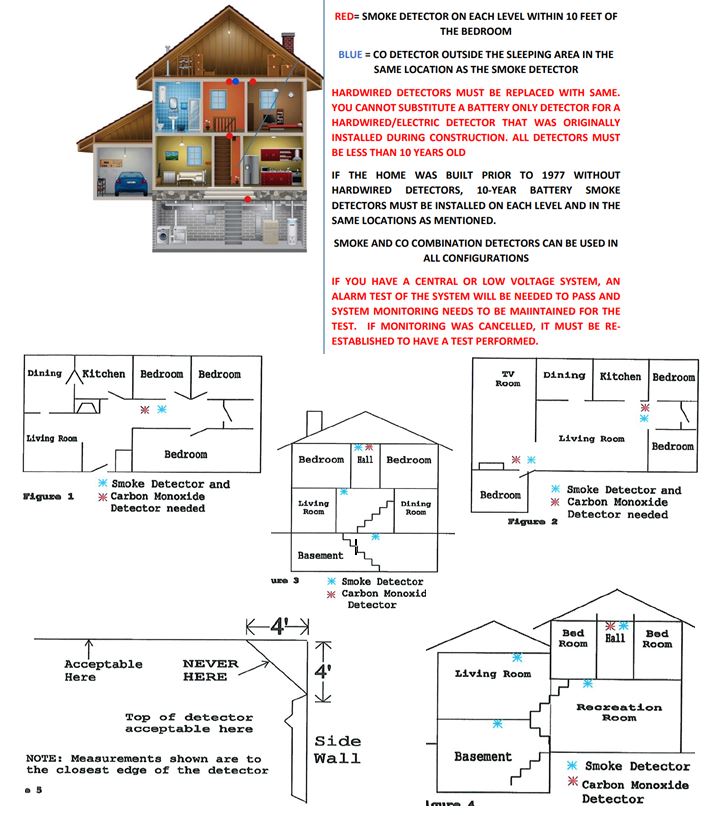Fire Prevention
The Fire Prevention office is open Monday through Friday from 8am to 4pm. To contact the office please either email fireassistant@oakland-nj.org or call 201-337-8111 x2025.
Fire Prevention Information for Fire Certificate
SMOKE DETECTORS
- Kitchens – Smoke from cooking may cause nuisance alarms.
- Bathrooms – Excessive steam from a shower may cause nuisance alarms.
- Near forced air ducts – Used for heating or ai conditioning – air movement may prevent smoke from reaching detector
- Near furnaces of any type – Air and dust movement and normal combustion products may cause a nuisance alarm.
Examples of where smoke detectors and carbon monoxide detectors should be placed

FIRE EXTINGUISHERS
- CAN I INSTALL BATTERY DETECTORS INSTEAD OF HARDWIRED ONES? Answer. NO. Building codes since 1977, require all detectors that were originally installed at the time of construction be maintained and up to date. If the home has hardwired detectors, then they must stay hardwired and be 10 years old or less. Homes built prior to 1977 did not have detectors installed and they can have battery only devices, one outside the bedroom and on each level of the home. See questions 4 and 13.
- HOW LONG DO DETECTORS LAST? Answer. Detectors made today are made to last 10 years. Any detector that is close to the age limit are advised to be replaced even though they may be within the timeframe. You need to replace them the new 10-year battery backup devices going forward. Recently, we have seen detector and the batteries being removed from the device and not replaced or replaced in a non-working order.
- I HAVE A LOW VOLTAGE SYSTEM, DO I NEED TO HAVE IT TESTED? A. YES. All low voltage system that are not part of the original construction must be tested annually by a qualified service. At the time of a sale, the system must have been tested and still be monitored within the same year of the sale with no errors or faults per the NFPA 72. The NFPA 72 form is the guideline the tester must use and the NFPA 72 report is what we need to see.
- DO I NEED TO HAVE MY BUILDING PERMITS CLOSED BEFORE A FIRE INSPECTION IS DONE? A. YES. All building permits and property maintenance violations must be closed before a fire inspection can be set up. If you have a building permit or property maintenance violation open the fire prevention clerk will advise you before setting up any inspection.
- DO FIRE EXTINGUISHERS GO BAD? A. YES. Fire extinguishers do have expiration dates. For residential they should have been purchased within the year of selling the home. It is suggested that the receipt is kept with the extinguisher for proof of purchase.
- WHEN DO I NEED TO SUBMIT THE PAPERWORK FOR THE CAO AND FIRE CERTIFICATION? A. The application for the CAO and Fire Certification should be submitted 30 DAYS prior to the closing date. This also allows time for any and all inspections needed and review of the paperwork.
- DO I NEED TO COMPLETE A CAO AND FIRE CERT FOR A SINGLE-FAMILY RENTAL PROPERTY? A. YES. For a single-family rental property, a Fire Cert and CAO is needed. If the property is on a well, a well report will be needed by the Board of Health. Also a Lead-Based Paint Safe Certificate will be needed as of July 2022 for all rental properties that were constructed prior to 1978. For more information regarding the Lead-Based Paint inspection contact our office and/or review page 7 and 8 of this packet.
For Local Businesses:
Please note that all businesses need to be registered with the Fire Prevention office. This will be initiated by filling out and completing a Commercial Certificate of Occupancy for all new businesses, change of ownership and/or change in tenant. This application is under 'Continued Certificate of Occupancy (CCO)' tab on the left hand side of this page.
If you have a current business in Oakland and have changes to your alarm company, management, contact information etc., please fill out the 'Update to Business Registration' form listed below and send to fireassistant@oakland-nj.org so your file can be updated.
Fire Prevention Permits:
Please use the 'Fire Prevention Permit App', linked below, for all permits that are needed, that are submitted separately from a Continued Certificate of Occupancy application. This includes (As Per N.J.A.C. 5:18-2.7 & Local Ordinance):
- Residential and commercial tent permits
- The use of any open flame or flame producing device, in connection with any public gathering, for purposes of entertainment, amusement or recreation
- Commercial welding or cutting operations except where the welding or cutting is permitted in areas approved for welding by the fire official and is registered as a Type B Life Hazard Use
- Any permanent cooking operation that requires a suppression system in accordance with N.J.A.C. 5:18-4.7(g) and is not defined as a Life Hazard use in accordance with N.J.A.C. 5:128-2.4
- For the storage, handling or use of flammable and combustible liquids
- Carnivals and circuses employing mobile enclosed structures used for human occupancy
- For a full list of all activities that require a Fire Prevention permit, please see email fireassistant@oakland-nj.org.
Contacts:
- Fire Official:
- Denny Knubel - 201-337-8111 x2025 - Email: fireoffical@oakland-nj.org
- Fire Prevention Inspectors:
- Tom Martin - 201-337-8111 x2025 - Email: fireinspector@oakland-nj.org
- Edward Lawler - 201-337-8111 x2025 - Email: fireinspector2@oakland-nj.org
- Fire Prevention Secretary:
- Krystal Berkowitz - 201-337-8111 x2025 - Email: fireassistant@oakland-nj.org
**Please note that the above email, fireinspector@oakland-nj.org, is not reviewed daily and can take 2 to 5 business days to be seen. Please contact Krystal Berkowitz at fireassistant@oakland-nj.org for a quicker response.**
| Attachment | Size |
|---|---|
| 153.49 KB | |
| 549.65 KB | |
| 523.85 KB |

